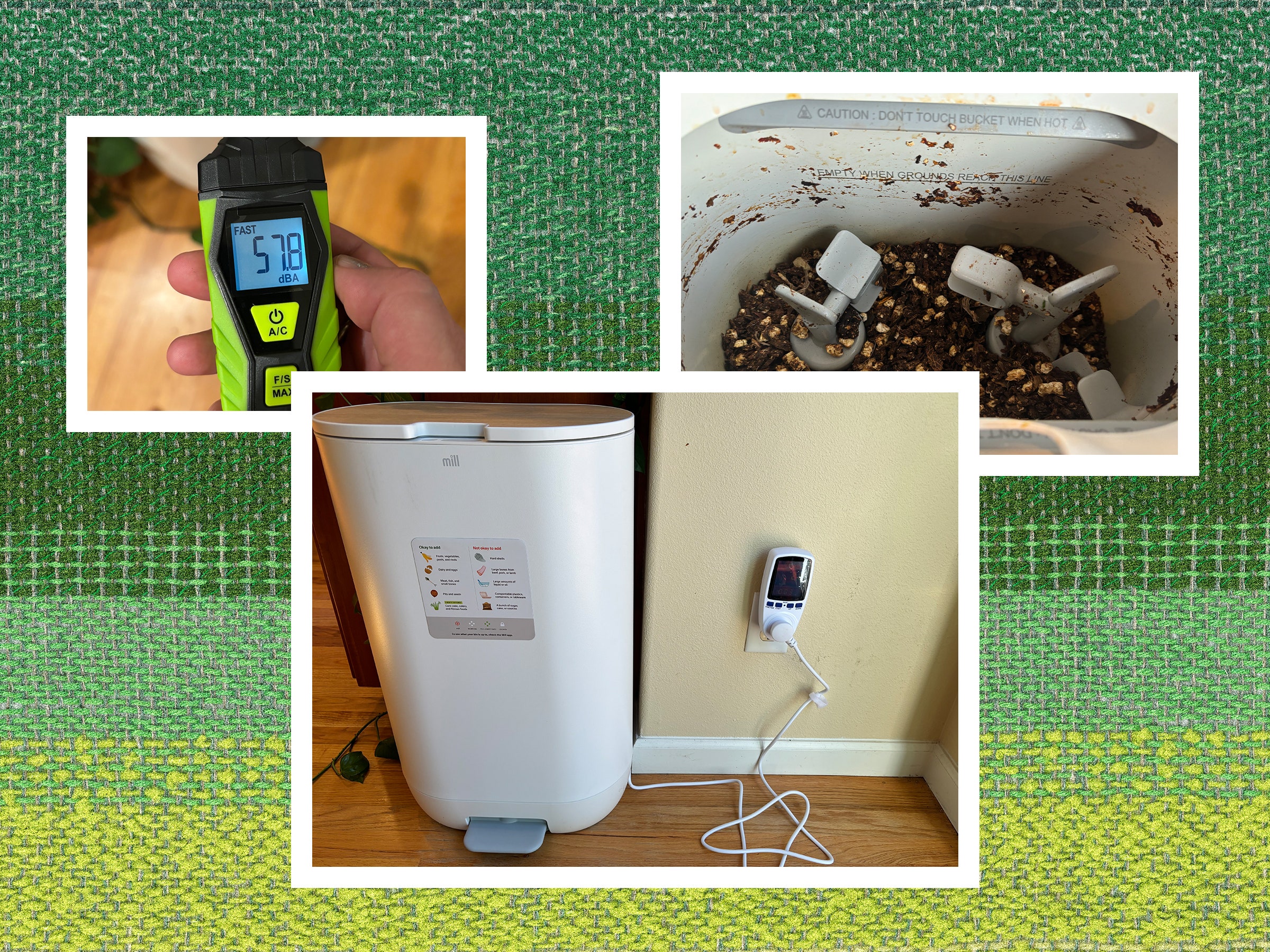I do not like composting.
I realize this is practically heretical given that I live just outside of Portland, Oregon, ground zero for environmental consciousness, but I’d just rather not have a container of slimy, rotting kitchen scraps sitting on my countertop. It attracts fruit flies and leaves my house smelling like federal-prison pruno—especially in the heat of summer.
Instead, my family of three has been relying on in-sink garbage disposal, which isn’t great. Our septic repairperson is adamantly against this, and garbage disposals are also a bad idea for those not on septic systems, because the refuse ends up in the waterways. Throwing food in the kitchen trash eventually leads to the local landfill, where uneaten food makes up 24 percent of municipal solid waste. Its breakdown results in the release of dangerous methane gas.
To combat this, many cities feature their own composting programs. My rural exurb does not, so I’m forced to choose between a normal-smelling kitchen and actively contributing to global warming. This is why I was especially interested in the Mill, an odorless, fully automatic food recycling bin dreamed up by Matt Rogers, former Apple engineer and cofounder of smart-thermostat pioneer Nest.
My prolifically home-cooking family tried the Mill for six weeks, connecting it to a power meter to test its output and cost of use, as well as feeding it as diverse a batch of food scraps as we could (including sauces, hundreds of eggshells, and a particularly vexing batch of melon rinds), to see whether this particularly pricey bin could be worth the cost to add to your household.
From the Grounds Up
There’s no denying that, at 50 pounds, about 27 inches tall, and 16 inches wide, the Mill requires a significant outlay of space. Even in my fairly spacious kitchen, finding someplace for the Mill to sit where it was both accessible and not in the way—and within a couple feet of a power outlet—was a challenge. For those short on counter space, the Mill being on the floor may give it an edge over countertop competitors like the Lomi.
Photograph: Kat Merck
It looks like the offspring of a Diaper Genie and a mid-century-modern–inspired trash can, but it grinds and dries food scraps in a 6.5-liter aluminum bucket. It connects to Wi-Fi and can be controlled via an app (iOS, Android), which provides an exhaustive list of what can and can’t go into the bucket (beef = yes; corn husks = no). You can also schedule when you want your Mill to go through its grind/dry cycle.
Once the bucket is full of grounds, users have a choice: arrange for the US Postal Service to pick up the grounds in a prelabeled box, or repurpose them in their yard. For the pickup option, Mill has a subscription plan ($10/month or $120/year) where users receive a bundle of cardboard boxes with plastic liners and ship a bucket’s worth of grounds to Mukilteo, Washington, where, a Mill spokesperson told me, the grounds will be “repurposed into an ingredient to feed chickens.” It takes a surprisingly long time to fill a bin. After six weeks, our bucket was only about half full of grounds.
Pests Away
Given the packaging, diesel, and other carbon-related costs associated with shipping the grounds—especially across the country, if you live on the East Coast—I worried about the environmental impact of boxing up the grounds. So I chose to repurpose them in my yard.
However, it bears keeping in mind that the Mill is a food recycler, not a composter, so the resulting grounds are not compost. Compost is biologically stable, the result of an anaerobic breakdown through decomposition. The Mill food grounds—or FG, in Mill literature parlance—are just your same kitchen scraps, ground up and dehydrated as if cooked in a giant air fryer. They have not broken down, and, as a page on the Mill app helpfully points out, immediately mixing FG into garden soil or spreading them on your lawn could cause them to rehydrate and attract “vectors” (raccoons, the guide helpfully specifies).
Photograph: Kat Merck
The Mill app suggests either putting FG in your existing compost pile or letting it sit for a minimum of two weeks before mixing it with potting soil. I did this, only to return to a pile of slimy fruit-core and vegetable-peel chunks beset by an even more unwelcome vector—maggots. Into the shipping box the rest of the grounds went.
As for the noise during the grind-and-dry cycle, Mill’s website claims it’s about 44 decibels, or about as loud as a dishwasher, but standing nearby with a decibel meter over the course of several nights, I measured between 57 and 60 decibels. It’s not a dramatic discrepancy, but a noticeable one—loud enough to need to turn the TV up if the Mill is in the same room.
Another peculiar quirk of the Mill’s operation is the extreme difference in cycle length. The Mill’s sensors set its cycle time—if it gathers that the grounds are dry and/or that nothing new has been added, it will cycle for only a couple hours or not at all. If it senses that the contents are wet, it could run its cycle for nearly 24 hours, as happened when I disposed of large chunks of an unappealingly textured watermelon.
For power output, the Mill’s dry-and-grind cycle ran at about 8.5 watts. Over my six-week trial, the Mill cost $3.03 to run at our city rate of 9 cents per watt, which was impressively efficient, given that some of its dry cycles ran for nearly an entire day.
Photograph: Kat Merck
Shrink and Ship
The Mill is a very cool gadget. To put vegetable peels and fruit rinds in at night and wake up to find them ground up and dehydrated to 20 percent of their original volume is impressive. It’s satisfying to know you’re doing your part to keep your waste out of the landfill, especially since the Mill app keeps a running tally of how many pounds you’ve diverted (our total: 38 pounds).
Plus, there really is no smell—a carbon filter (a year’s worth runs $60) in the back ensured the Mill contents remained odorless at all times, even during a heat wave when we were out of town and had our central air conditioning turned off.
Given the Mill’s unknown longevity and short 12-month warranty, though, it raises the question of whether the average family will be able to recycle enough food waste to offset the impact of the bin’s manufacturing and shipping, as well as the ongoing shipping and transport of its grounds.
Photograph: Kat Merck
When I raised this question to Mill, a spokesperson said grounds “could be transported 15,000–20,000 miles before the carbon cost outweighs the benefits of using Mill.” Supposing that’s true, the main issue then lies in the price, especially since grounds pickups aren’t included in the thousand-dollar layout. At one time there was a monthly rental option for the Mill, but as of press time that option is no longer available on its website.
One could justify that the Mill’s overall cost per month would be comparable to a municipal yard waste container, as Mill’s literature indicates it would be replacing, but yard waste explicitly cannot be put into the mill. It’s for food scraps only, and not all food scraps at that (no liquids, large amounts of baked goods, moldy food, or fibrous items like corn husks or artichoke leaves).
If you have the money and don’t want to compost in the traditional way, the Mill is an excellent, techy solution—“a compost bin for guilty rich people,” as one online review called it. But for the rest of us, a lower-cost solution—or even putting up with a slimy, low-tech kitchen container—makes more sense.










